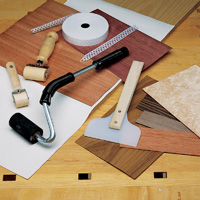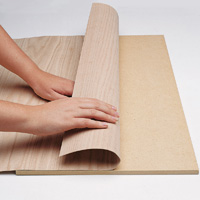







 Methods for Applying Wood Veneer
Methods for Applying Wood Veneer
There are a number of acceptable methods for applying veneer. From the time-honored craft of hammer veneering to modern vacuum press veneering, each method has its advocates and applications where it works best. Although many woodworkers have their favorites, there is probably no one method that is the best choice for all situations. The method to choose depends on the type of project you are doing and the amount of time and expense you want to devote to your veneering project.
Hammer Veneering
Hammer veneering is the oldest method of applying wood veneer to a substrate. A veneer hammer, which is really more of a stiff, blunt metal scraper attached to a long handle, is used to smooth out the veneer on the substrate, and to squeegee out excess amounts of the heat-activated glue used in the process. Traditionally, hide glue in the pearl form is used for hammer veneering because of its consistency and long open time.
Hammer veneering with pearl glue has a few advantages. Because the glue is thermo-activated, it can be revived with a hot iron after it has set to fix mistakes and work out any bubbles found between the veneer and the substrate. In addition, it is a relatively simple process and requires only a few tools. And with examples of hammer veneered pieces applied in 1500 B.C. still holding on, it's safe to say that veneer applied with this method can stand the test of time.
Veneering with Mechanical or Hydraulic Press
Veneering with a mechanical press is a straightforward process - veneer is positioned on an adhesive coated substrate, a caul (a flat piece of wood used to help distribute the pressure evenly) is placed on top of the veneer, and the three are clamped together with hydraulic or mechanical veneer press clamps. Using a mechanical or hydraulic pressure for applying veneer is a reliable method, but the presses - especially large scale ones - can be time-consuming and unwieldy to use. In addition, a good sized mechanical press is heavy and takes up a lot of shop-room.
Using a small-scale homemade mechanical press is a good choice if you don't plan to do a lot of large or curved pieces and you're looking for an inexpensive solution. A serviceable press can be made using nothing more than a few 2'' X 2'' hardwood crossbearers, a couple pieces of 3/4'' sheet material, lengths of 3/8'' threaded rod, wingnuts and washers. If you're sold on mechanical press veneering, you can build your own full-scale press using construction lumber and handscrew clamps.
 Veneering with Contact Cement
Veneering with Contact Cement
As the name implies, contact cement bonds the veneer to the surface of
the substrate on contact.Applying veneer with contact cement is a fast, inexpensive method that will yield good results if it's done right. The
contact cement method is actually one of the easiest veneering methods, and is very reliable provided you use a high quality adhesive and
understand how to use the adhesive correctly. If you're new to veneering and want to get your feet wet with a simple method, try our step by step instructions in Veneering with Contact Cement for your first project.
Veneering with a Vacuum Press
A vacuum press consists of a vinyl bag with a pump attached to evacuate the air from the bag. The press relies on atmospheric pressure to press the veneer against the substrate while it is being glued. Vacuum presses produce a surprising amount of clamping pressure - at 25 Hg (inches of mercury) a vacuum press will exert 1872 lbs. of pressure on a 1 square foot piece of wood. But besides producing ample force, a vacuum press has features that make it just about the perfect method for applying veneer. Unlike mechanical clamping systems, a vacuum press applies even, consistent pressure over the entire surface of the workpiece, creating "intimate contact" between the veneer and the substrate. Additionally, a vacuum press actually draws air out of the cells of the wood, which is replaced by adhesive. According to adhesive manufacturers, intimate contact and cellular penetration are the two most important features in creating an optimum bond.
For all of the advantages that a vacuum press offers, it's a relatively inexpensive system to set up. For a few hundred dollars, you can put together a vacuum press system that allows you to veneer not only large surfaces, but also allows you to veneer curved surfaces with a fraction of the set-up time it would take using a mechanical press. And for woodworkers who want an especially economical entry point into vacuum veneering, there's a hand operated system that makes all the benefits of vacuum press veneering available for smaller projects for less than the price of a few good C-clamps. If you want to try vacuum press veneering with a system that'll put a lot of pressure on your projects, but not much on your bank account, check out Rockler's Veneering with the Thin Air Vacuum Press Kit. It's got all of the information you'll need to get started using a vacuum press that'll give you the perfect introduction to one of the best veneering techniques available.
... that managed forests, thanks to their high proportion of young, strong, growing trees, enable CO2 to be extracted?
... that an old, unmanaged forest produces as much CO2 through processes of decomposition and decay as it stores, and that therefore an unmanaged forest contributes nothing to reducing global CO2?


The Veneer Source • 400B Pittman St, Orlando, FL 32801
Phone: 407-423-2252 • Fax: 407-423-1566 • sales@veneersource.com
Phone: 407-423-2252 • Fax: 407-423-1566 • sales@veneersource.com